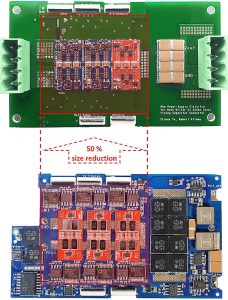IC Compatible Power Supply Circuitry for Gate Driver of Flying Capacitor Multi-Level Converters
PhD student Zichao Ye with advisor R. Pilawa-Podgurski
Flying capacitor multi-level converters (FCMC) have received increased attention for medium- to low-power designs. Compared to conventional two-level converters, FCMCs have the advantages of lower device stress ratings, greatly reduced inductor values, increased effective ripple frequency and reduced dv/dt transients. There are many demonstrated examples showing a higher conversion efficiency and higher power density than their conventional two-level counterparts. However, a major challenge is providing power to the gate-driving circuitry, as the switch terminals are all floating. The existing method utilizes an isolated dc/dc converter, which is bulky and energy inefficient. One innovative circuit based on a bootstrapping method is proposed to power the floating switches, without the need of isolated dc/dc converters. Called synchronous bootstrap, it replaces the traditional bootstrap diode with a self-controlled GaN FET so that the voltage drop associated with the diodes can be eliminated and the bootstrapping operation can be cascaded without limitations. This circuit has a low profile and can be placed close to the GaN switch, so that the overall power density of the converter can be improved significantly, as shown in Figure 19. Future work is to integrate the synchronous bootstrap circuit with the gate driver to create a single IC. This research is supported by Texas Instruments.
